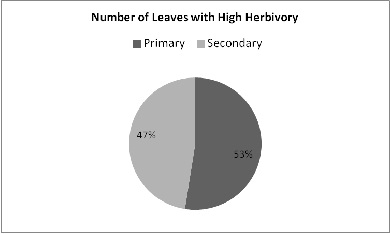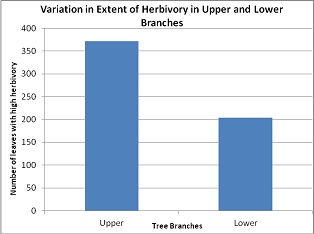Any and all opinions expressed in this newsletter are solely those of the author(s) and do not reflect the opinion of ATREE.
Centre for Excellence in Conservation Science
Royal Enclave,Srirampura,Jakkur Post
Bangalore-560064
Telephone: 080-23635555 (EPABX)
Fax : 080- 23530070
The aim of our visit to the Kalakad –
Mundanthurai Tiger Reserve from the 4th to
the 11th of May, 2012 was to study plantanimal
interactions as part of the elective
course at ATREE. Following preliminary
reconnaissance and brainstorming, we
decided to select one particular interaction -
the extent of herbivory on leaves of
Macaranga peltata, to conduct field
observations. The varying availability of
sunlight, nutrients, plant density and species
diversity, known to influence resource
availability in primary and secondary forest.
We set out to test a few hypotheses which
were based on the 'resource concentration'
and the 'theory of plant apparency'. The
resource concentration hypothesis states
that the incidence of herbivory is proportional
to the availability of the resource (plants).
According to the theory of plant apparency,
the discovery of a plant by herbivores is
dependent upon the microclimatic conditions
such as sunlight, location of leaves on a plant
and the location of the plant itself in a patch.
The theory assumes that plants that are
prone to discovery tend to invest more in
quantitative defenses such as reduced
digestibility. The two theories are not mutually
exclusive, and each one is a corollary of the
other.
We hypothesized that the extent of herbivory
would be higher in secondary growth forests
where M. peltata was found in higher density
compared to primary growth forests.
Furthermore, we also sought to investigate if older trees reported greater herbivory
compared to younger ones. At the same time,
we sought to understand if the leaves in the
upper branches which are exposed to
sunlight are more prone to herbivory
compared to leaves in the shaded lower
branches irrespective of occurrence in
primary or secondary forests.
Over the week we established a total of 30
square plots measuring 10 x 10 sq m, 15 each
in primary and secondary evergreen forests.
Within each plot, we measured the height and
diameter of the M. peltata trees. The ratio of
non-predated leaves to predated leaves was
considered as a measure of herbivory.
Secondary forests carried a higher average
number of M. peltata individuals per plot.
Primary forest plots had fewer M. peltata
trees but the overall tree density was higher
than in secondary forests. The M. peltata
trees in primary forest plots also displayed a
higher mean height as well as girth than those
in secondary forest plots.
The findings showed that the incidence of
herbivory was marginally higher overall in the
primary forests than in secondary forests.
This finding was not in accordance with our
initial hypothesis. Second, we found that
although younger trees suffered herbivory to
a greater extent relative to older ones the
relationship was not a strong one. Third,
regardless of the forest type, herbivores in
general preferred the upper branches of trees
irrespective of their occurrence in primary or
secondary forests. Thus, the findings of this
study do not support the resource
concentration hypothesis. However, they
appear to provide evidence to the theory of
plant apparency with respect to M. peltata
trees.
Editorial Team
Editor: Allwin Jesudasan
Associate editor: Rajkamal Goswami
Editorial Review: R. Ganesan, M. Soubadra Devy, T. Ganesh
Design and presentation: Kiran Salagame
A S H O K A T R U S T F O R R E S E A R C H I N E C O L O G Y A N D T H E E
N V I R O N M E N T
Research Highlights
Herbivory on Macaranga peltata
- Ovee Thorat, Ronita Mukherjee,
R. Venkat Ramanujam and Vikram Aditya
If you have any suggestions or comments please let us know through the boxes below







